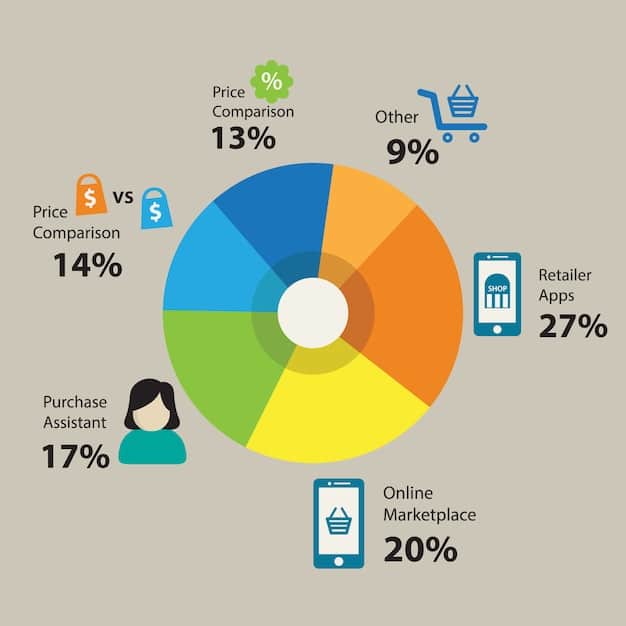Inflation’s Long-Term Impact on Your Portfolio: Timeless Reports

Timeless Reports: The Truth About Inflation and Its Long-Term Effects on Your Portfolio analyzes how inflationary pressures erode investment value over time, impacting asset allocation and long-term financial security, and offers strategies to mitigate these risks.
Inflation is a silent wealth killer, gradually diminishing the purchasing power of your savings and investments. Timeless Reports: The Truth About Inflation and Its Long-Term Effects on Your Portfolio sheds light on this crucial aspect of financial planning, offering insights into how inflation impacts your investments and strategies to protect your financial future.
Understanding Inflation: A Primer
Inflation, at its core, is the rate at which the general level of prices for goods and services is rising, and subsequently, purchasing power is falling. It’s a fundamental economic concept that affects everyone, from everyday consumers to large-scale investors.
But what are the real drivers behind inflation, and how can you discern between temporary price hikes and a sustained inflationary trend?
The Roots of Inflation
Inflation can stem from various sources, demanding vigilant monitoring to grasp its lasting effects on your portfolio. Cost-push inflation arises when the expenses of producing goods and services increase. Demand-pull inflation occurs when there is an increase in demand that is not met with an equal increase in supply of goods and services.
These forces interact in several ways to shape the macroeconomic environment.

Measuring the Beast: Key Inflation Indicators
Tracking inflation involves monitoring several key economic indicators such as the Consumer Price Index (CPI), which measures the average change over time in the prices paid by urban consumers for a basket of consumer goods and services. Also consider the Producer Price Index (PPI), which gauges price changes from the perspective of sellers.
Additionally, keep an eye on other economic data to gauge an overall environment of inflationary pressure.
- GDP Growth: Provides insights into the overall economic activity level.
- Unemployment Rates: Can indicate wage pressures that might lead to inflation.
- Federal Reserve Policies: Decisions on interest rates and money supply heavily impact inflationary trends.
In summary, understanding the fundamentals of inflation and its underlying causes is crucial to protecting your portfolio. By monitoring key indicators and staying informed, you can navigate the economic landscape and make informed investment decisions.
How Inflation Erodes Portfolio Value
Inflation’s impact on your portfolio can be subtle but significant over the long haul. It has the power to erode the real value of your investments, meaning that your returns may not be as substantial as they appear at first glance.
To safeguard your financial future, you need to understand how inflation affects various asset classes and how to adjust your portfolio accordingly.
The Impact on Different Asset Classes
Different asset classes react uniquely to inflationary pressures, understanding these nuances is critical for effective management strategies. Bonds, for example, are particularly vulnerable to inflation because their fixed interest payments become less valuable as prices rise. Equities, on the other hand, can sometimes act as an inflation hedge, as companies may be able to increase prices along with inflation.
Real estate is often considered an inflation hedge, as property values and rental income tend to increase with inflation.
Inflation-Adjusted Returns: The Real Story
The nominal return on an investment denotes the pre-inflation profit from an investment. However, inflation-adjusted return takes into account the impact of inflation. By subtracting the inflation rate from the nominal return, you can get a more accurate picture of your investment’s actual performance.
Ignoring inflation-adjusted returns could lead to an overestimation of portfolio growth.
- Calculate Inflation-Adjusted Returns: Subtract the rate of inflation from your nominal return.
- Compare Against Benchmarks: Assess your portfolio’s real growth against inflation-adjusted benchmarks.
- Rebalance Strategically: Adjust your allocations with consideration for real rate of return.
In conclusion, inflation can significantly erode portfolio value, especially if your investments are not properly adjusted to account for rising prices. By understanding how inflation impacts various asset classes and focusing on inflation-adjusted returns, you can make informed decisions to protect and grow your wealth.

Strategies to Combat Inflation’s Bite
Counteracting inflation’s impact on your portfolio necessitates a strategic approach. There are varied tactics you can use to protect your wealth. These include investing in assets with the capability to outpace inflation and actively managing your portfolio.
Adjusting your investment approach can help you stay ahead in an inflationary climate.
Inflation-Resistant Asset Classes
Certain asset classes are inherently more resistant to inflation. These assets tend to maintain or increase their value during periods of rising prices. Treasury Inflation-Protected Securities (TIPS) are designed to protect investors from inflation. They provide investors with a fixed rate of interest while adjusting the principal amount to reflect any increases or decreases in the CPI.
Commodities, such as gold, oil, and agricultural products, can serve as an inflation hedge. Real estate can act as an inflation hedge, as property values and rental income tend to increase with inflation.
Active Portfolio Management
In the dynamic landscape of inflation, active portfolio management becomes indispensable. It involves making tactical adjustments to your asset allocation and investment strategies to optimize returns while minimizing the impact of rising prices. Monitoring inflation indicators and adjusting strategies accordingly is very useful.
Employing diverse approaches can help maximize your portfolio’s resilience.
- Diversify Your Portfolio: Mix assets that respond differently to inflation.
- Rebalance Regularly: Ensure your allocations align with current expectations.
- Seek Professional Advice: Consult financial advisors for personalized recommendations.
By employing inflation-resistant asset classes and engaging in active portfolio management, you can mitigate the adverse effects of inflation and position your portfolio for long-term success. A proactive approach is key to protecting your wealth in an inflationary environment.
The Role of Interest Rates and Monetary Policy
Understanding the relationship between interest rates, monetary policy, and inflation is critical for making informed investment decisions. Interest rates, set by central banks like the Federal Reserve, can significantly influence inflation levels. Monetary policy refers to the actions undertaken by a central bank to manipulate the money supply and credit conditions to stimulate or restrain economic activity.
These tools are key to managing inflation and navigating economic cycles.
How Interest Rates Impact Inflation
When inflation rises too high, central banks often respond by raising interest rates. Higher interest rates make borrowing more expensive, which can reduce spending and investment, thereby cooling down the economy and curbing inflation. Conversely, when inflation is low, central banks may lower interest rates to encourage borrowing, spending, and investment, which can stimulate economic growth and push inflation higher.
The Fed will often manipulate interest rates to target a specific inflation rate.
Federal Reserve’s Tools for Inflation Control
The Federal Reserve has various tools at its disposal to manage inflation. One of the primary tools is adjusting the federal funds rate, which affects the interest rates that banks charge each other for overnight lending. Another major mechanism involves the Federal Reserve balance sheet.
These strategies collectively contribute to the Fed’s overall approach to inflation management.
- Open Market Operations: Buying and selling government securities to influence the money supply.
- Reserve Requirements: Setting the percentage of deposits banks must hold in reserve.
- Forward Guidance: Communicating intentions to shape market expectations.
In essence, the interplay between interest rates and monetary policy is a critical factor in controlling inflation. By understanding how these mechanisms function, you can better anticipate market movements and adjust your investment strategies accordingly. Staying informed about central bank policies is vital for navigating the economic landscape and protecting your portfolio.
Inflation and Retirement Planning
Inflation casts a long shadow over retirement planning, demanding careful consideration to ensure your savings retain their purchasing power. Factoring inflation into your retirement projections and adopting strategies to protect your retirement income are of utmost importance.
Failing to account for inflation can result in an underfunded retirement plan.
Estimating Future Inflation Rates
Predicting future inflation rates involves considering historical statistics, contemporary economic trends, and expert opinions. Government reports such as the Consumer Price Index (CPI) and Federal Reserve forecasts offer insights into potential inflation trajectories. Incorporating a range of scenarios into your retirement projections is critical.
Protecting Retirement Income from Inflation
Protecting your retirement income from inflation involves making strategic choices about your asset allocation and withdrawal strategies. Annuities can offer a steady stream of income adjusted for inflation. Social Security benefits include cost-of-living adjustments (COLAs) to help maintain their purchasing power.
- Diversify Investments: A mix of assets can hedge against inflation.
- Delay Social Security: Benefits increase with delayed claiming.
- Consider Part-Time Work: Supplement retirement income to offset rising costs.
In conclusion, integrating inflation considerations into your retirement planning is paramount for a secure financial future. By estimating future inflation, considering inflation-adjusted assets, and implementing proactive strategies, you can safeguard your retirement income and maintain your desired lifestyle. Diligent planning is the cornerstone of a successful, inflation-resilient retirement.
Adjusting Your Financial Plans for the Future
The long-term effects of inflation necessitate a continuous review of your financial plans. Regular adjustments to your budget, savings goals, and investment strategies are crucial for maintaining financial stability and achieving your objectives. Adaptability is crucial under uncertain economic conditions.
Adapting to the evolution of inflation is a constant need.
Budgeting and Savings in an Inflationary Environment
Revising your budget involves identifying areas where costs are rising and adjusting your spending accordingly. Setting realistic savings goals based on inflation-adjusted projections is critical for maintaining progress toward long-term financial objectives. Exploring opportunities to increase your income can help offset the impact of rising prices.
Reassessing Investment Strategies
Reviewing your investment strategies involves evaluating your asset allocation, assessing risk tolerance, and making necessary adjustments. Taking this measure can guarantee that your portfolio is well-positioned to endure inflation. Consider consulting a financial adviser so they can provide specialized insights.
- Review Expenses: Identify areas to reduce spending.
- Set Realistic Goals: Use inflation-adjusted targets.
- Explore Income Options: Consider side hustles or passive income streams.
In summary, the long-term effects of inflation require a proactive and adaptable approach to your financial plans. By continuously reviewing your budget, adjusting your savings goals, and reassessing your investment strategies, you can mitigate the impact of rising prices and maintain financial stability. Being proactive keeps you on track toward achieving your long-term financial goals.
| Key Point | Brief Description |
|---|---|
| 📈 Inflation Impact | Erodes purchasing power & investment returns. |
| 🛡️ Strategies | Invest in TIPS, real estate, and commodities. |
| 💰 Retirement | Factor inflation into retirement projections. |
| 🏦 Interest Rates | Central banks use rates to manage inflation. |
Frequently Asked Questions
▼
Inflation is the rate at which the general level of prices for goods and services is rising, and consequently, the purchasing power of currency is falling. This means you need more money to buy the same things over time.
▼
Assets like real estate, commodities (such as gold and oil), and Treasury Inflation-Protected Securities (TIPS) often perform well during inflationary periods, as their values tend to increase with rising prices.
▼
You should estimate future inflation rates and adjust your savings goals accordingly. Consider investing in assets that can outpace inflation and reassess your withdrawal strategy to ensure your income keeps up with rising costs.
▼
Central banks often raise interest rates to combat inflation. Higher rates make borrowing more expensive, which can reduce spending and cool down the economy, thus curbing inflation. Lower rates encourage spending which can increase inflation.
▼
It’s advisable to review your financial plans at least annually, or more frequently if there are significant changes in inflation rates or your personal financial situation. Regular monitoring allows for timely adjustments to your strategies.
Conclusion
In conclusion, understanding inflation and its long-term effects on your portfolio is critical for securing your financial future. By staying informed, diversifying your investments, and adjusting your financial plans, you can mitigate the risks posed by inflation and achieve your long-term financial goals.





